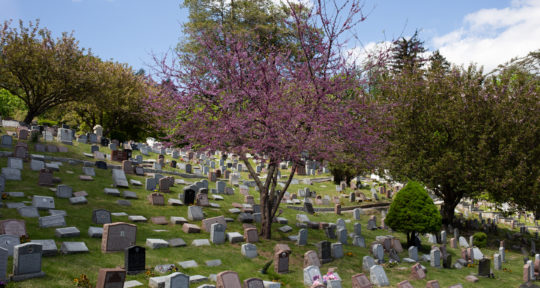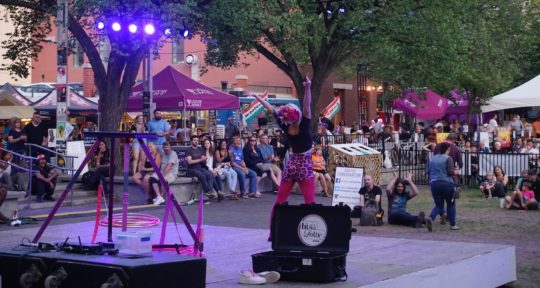I am sitting on the ground with a 4-foot-wide map spread out in front of me, held down with rocks. I shiver in the freezing desert air, as I try to make sense of where I am on the map, and where I’m going. I look around. I can barely make out the snow-capped peaks looming in the distance, but I know they’re there.
It’s just past 5 a.m., and moments ago I was still asleep in my tent. The sun isn’t even up—and won’t be for a couple more hours. Still, the sounds of people waking up and stirring echo around me in the darkness. It’s a stereophonic symphony of tents unzipping and maps being unrolled.
There are almost 100 of us, all women. We’re camped out in Kingston, a tiny town in the smack-dab center of Nevada, surrounded by mountains, canyons, and desert. The population of 113 is still asleep and the town sits quietly and comfortably away from civilization.
There’s not much here except for a rustic, Old West-inspired saloon and the charming, family-owned bed and breakfast whose lawn we’ve turned into a makeshift campground for the night.
Within minutes of the wakeup call, maps are spread out on every surface available, from picnic tables to hoods of 4x4s to the ground. Headlamps and flashlights cast tiny spotlights onto stacks of compasses, plotters, minute rulers, and calculators.
“It’s too early for math,” a woman whispers next to me, while scribbling complicated-looking equations onto a pad of paper.
This is day one of the 2018 Rebelle Rally.
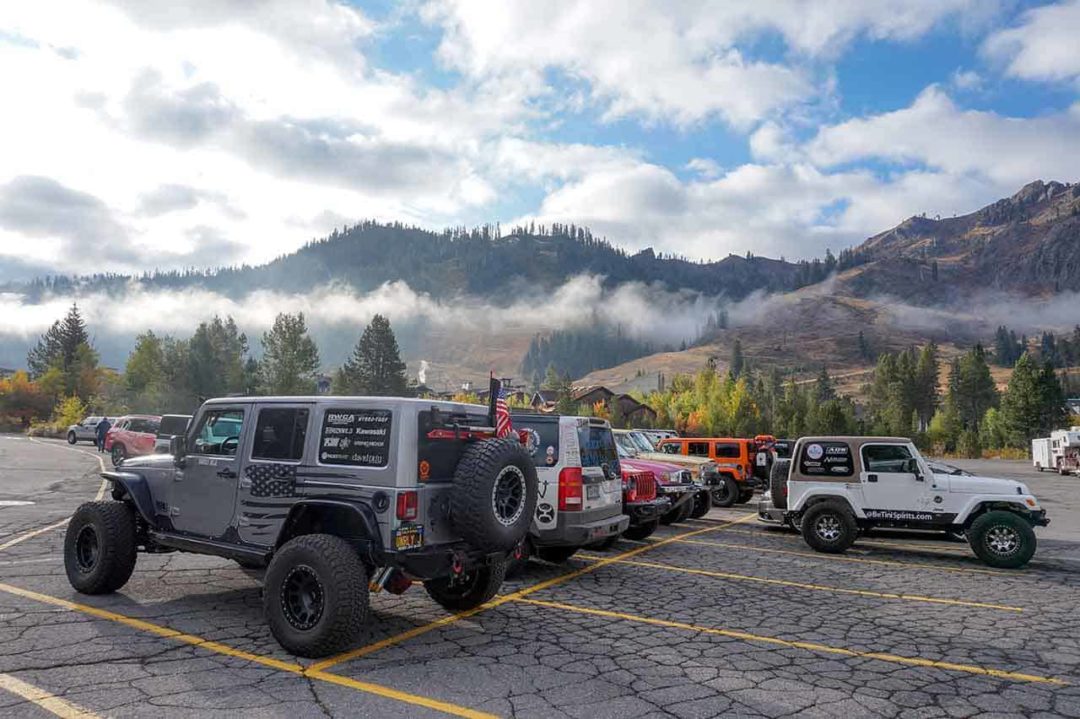
A world-class competition
Navigating can be hard. Doing it without the help of GPS or satellite navigation is immensely more difficult. And, yet, that’s what we’re here to do. It’s mid-October and, just a few days ago, 86 women from across the globe arrived at Palisades Tahoe Ski Resort—just north of Lake Tahoe, California. By the end of next week, the 43 teams of two will have made their way through 1,600 miles of mostly off-road trails, all the way to the finish line in San Diego, California.
Palisades Tahoe was the host site of the 1960 Winter Olympics and is a popular ski destination. Now, though, it sits quietly between seasons: There’s no snow yet, but it’s too cold for most summer activities. Instead, the parking lot of the resort’s convention center is filled with off-road vehicles—Jeeps, Toyotas, Land Rovers, one lonely Porsche—wrapped in multi-colored team names and sponsor logos.
As the morning’s first rays of sun struggle to break through the heavy fog embracing the surrounding mountains, rally competitors are lining up for finishing touches: Vehicle decals, sack lunches, one final pep talk.
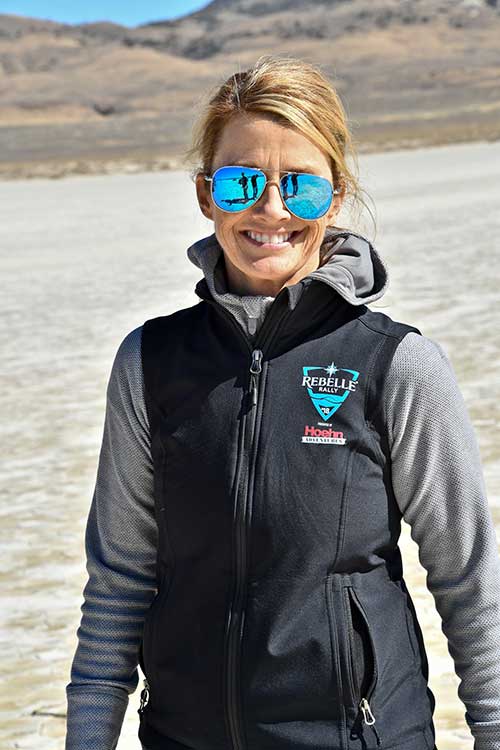
Started in 2016 by Emily Miller, the Rebelle Rally is a women-only off-road navigation rally, the first of its kind in the U.S. It’s the rally Emily—a former racer for Rod Hall Racing and well-known name in off-roading—always wanted to compete in. But since it didn’t exist, she had to create it herself.
Emily is a powerhouse. Despite greeting everyone with smiles and friendly advice, she exudes confidence and a deep-rooted passion for making the Rebelle Rally a first-rate event.
“This is not just a journey to drive down the road,” Emily says, not without a hint of pride. “We are a world-class competition.”
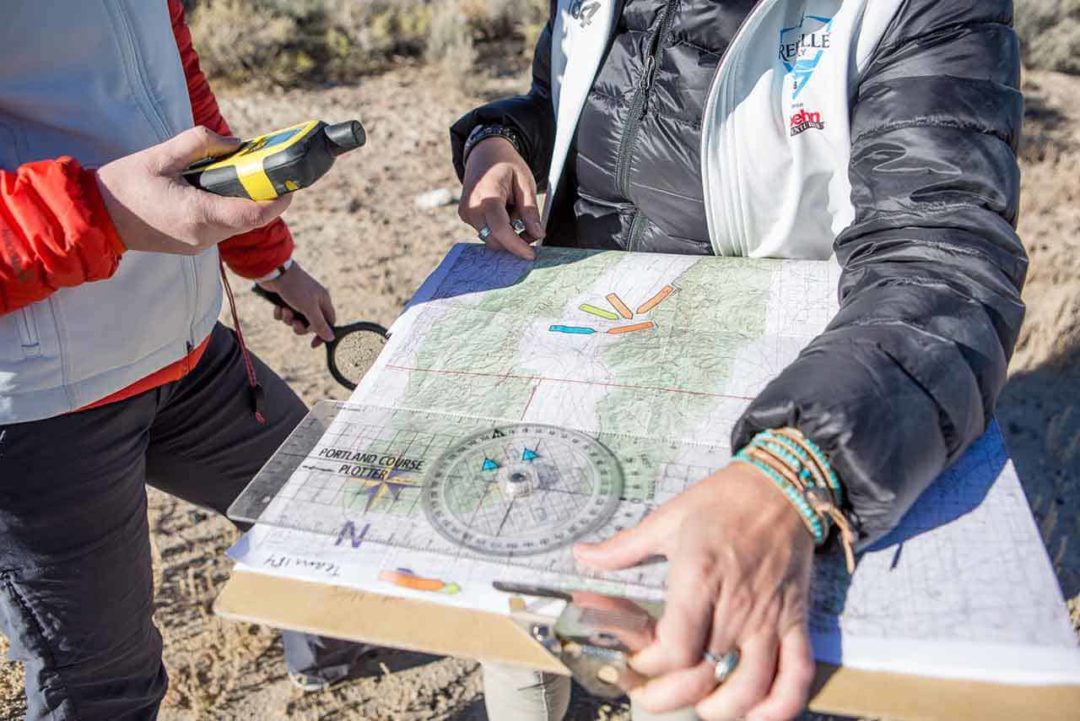
Each day during the weeklong rally, teams consisting of a driver and a navigator have to locate a number of checkpoints on a map, using a plotter and ruler. They then drive to the checkpoints in real life, using distance and a compass. The use of GPS is strictly prohibited—competitors are required to lock up their phones at the start of the rally and not touch them again until they cross the finish line.
The inspiration for the Rebelle comes from Rallye Aïcha des Gazelles, a women’s off-road navigation rally held annually in Morocco. But, as several people who’ve competed in both rallies told me, the Rebelle is a completely different challenge.
IF YOU ALWAYS KNOW WHERE NORTH IS, THEN YOU CAN TELL WHERE EVERYTHING ELSE IS.
For one, the Morocco rally is all about driving straight. It takes place largely in the sandy dunes of the Sahara desert, where there’s nothing to navigate around. Accordingly, the team getting to its checkpoints with the least distance driven collects the most points.
In the U.S. terrain, going straight is usually not an option. Instead, competitors need to navigate around mountains, lakes, infrastructure, and more—but without ever losing track of the direction they’re going.
“If you always know where north is, then you can tell where everything else is,” Emily says.
The “Rebelle” in the name—a fusion of the words “rebel” and “belle”—describes a beautiful woman who defies convention. It’s an apt description, as there are some seriously badass women here.
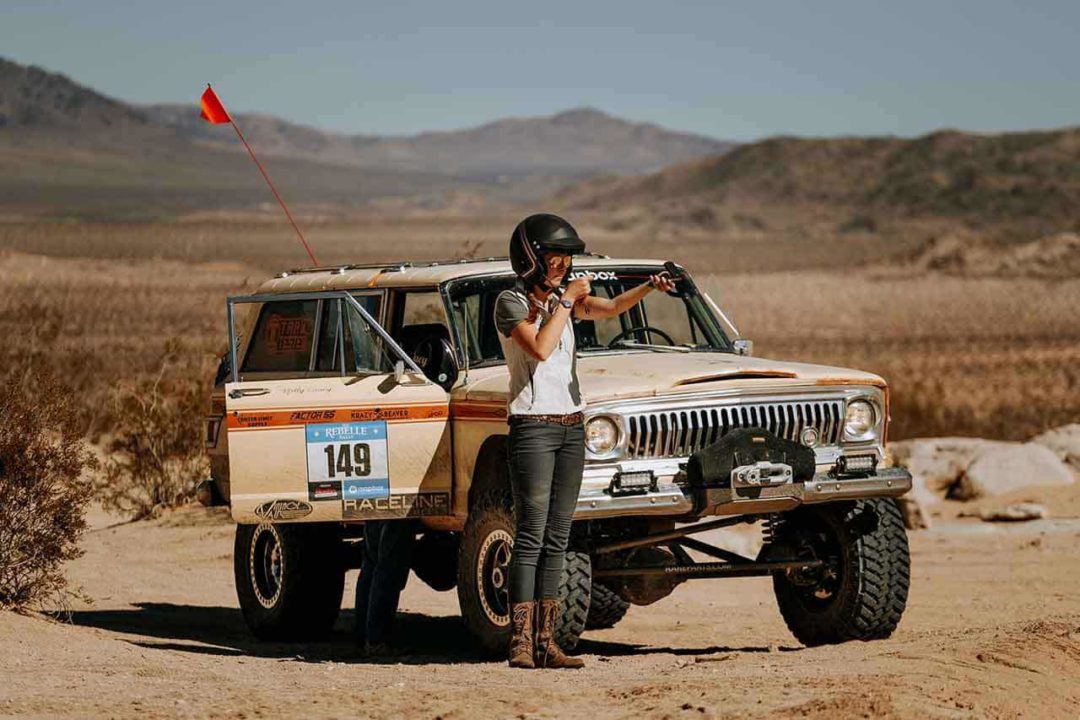
Courtney Latter, one half of team Trail Tested, is driving a 1969 Jeep Wagoneer—the oldest and probably most distinct vehicle at the event. The tan Jeep is no trailer queen, though. Courtney found it in a field and bought it as a project specifically for the Rebelle. She and her boyfriend got it running together. ”It had no motor and was full of rat poop,” she says. Now it’s going strong—it even has air-conditioning.
Sedona Blinson, a three-time Rebelle competing on team Wild Grace, was pregnant when she first heard of the rally in 2016. Fast forward a few months and Sedona was pausing at checkpoints to pump breast milk for her eight-month baby back at home. To not waste the milk, she had to haul a freezer along in her truck throughout the rally. Sedona admits that this, as one might expect, was a “whole other level of challenging.”
“I knew, however,” Sedona says, “that being able to walk away having competed and finished the first Rebelle Rally while pumping would leave me with an incredible strength as a mom.”
Always look out for drones
We’re a few days into the competition and I’m standing on a plateau overlooking a steep dirt road, plunging into a desert valley. There are several vehicles, mostly Jeeps, parked around me. The navigators have their compasses out, using characteristics of the surrounding landscape to triangulate their location. An especially imposing mountain peak at 225 degrees; a fork in the road at 50 degrees; a lake somewhere in the distance—it all translates to features on the map, and can help competitors figure out exactly where they are at any given moment. That, and knowing where north is.
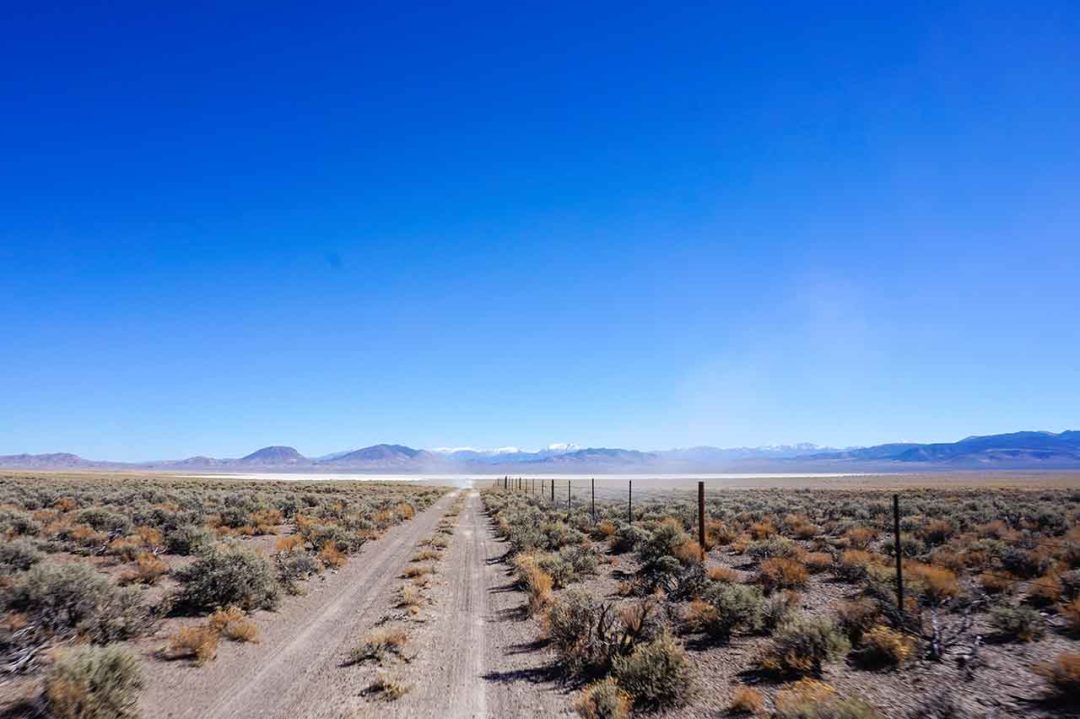
A drone is buzzing like a giant robotic mosquito in the air above us. The Rebelle Rally’s extensive media team follows along and documents all stages of competition. Sometimes they hide to avoid giving away routes or checkpoint locations, which has sparked an important rule among competitors: When you pull over to go to the bathroom on the side of the road, always look out for drones.
Before this week, my experience with off-roading was limited to a dangerous, injury-laden, and not-fully-thought-through dirt-bike tour of the Peruvian Andes a few years back. However, I’m quickly starting to understand what makes people love this.
Nevada’s backcountry is vast and ever-changing. On my first day at the Rebelle, someone told me that this state has more mountain ranges than the country of Afghanistan. I haven’t been able to verify whether that’s true. There sure are a lot of mountains here, though, so it does feel plausible. There are also sprawling valleys, dry lake beds, forests, boulders, Joshua trees, sand dunes, and any other imaginable topography.
Driving on a highway, you only see some of it. For every wrong turn on the Rebelle, there’s a new landscape you wouldn’t have otherwise seen or even known was there.
I’m tagging along with Dan and Zach, two of the videographers hired to film the rally, in Dan’s truck. Unlike the competitors, they have a GPS app showing the different routes and checkpoints pulled up on a phone on the dashboard. It also shows the locations of all the teams in real time.
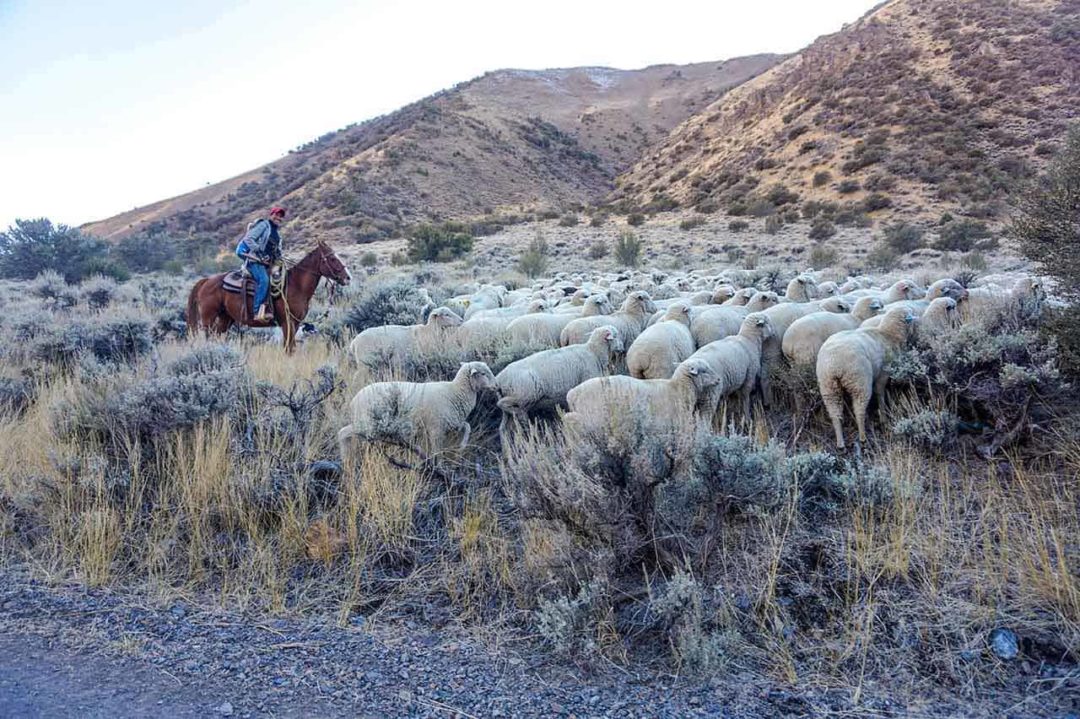
As we race ahead, taking shortcuts to beat competitors to some of the more scenic checkpoints, we joke about how we have no idea what lies beyond the next crest. The landscape keeps shifting. One second there’s nothing but sand in every direction; the next we’re surrounded by shiny hills covered in something teal and metallic-looking. I suddenly wish I had taken some geology classes. Who knew there were so many different kinds of desert?
Most of these locations lie largely untouched, far from any paved roads, cities, or highways. We run into flocks of wild horses, grazing on a hillside. A few times we cross paths with solo sheepherders on horseback, patiently instructing their dogs to round up dozens of sheep so our vehicle can squeeze by. They show up out of nowhere and disappear just as quickly, leaving us wondering what brings anyone that far away from civilization.
Las Vegas, with its bright neon lights and around-the-clock debauchery, is only a few hours away. It might as well be on a different planet.
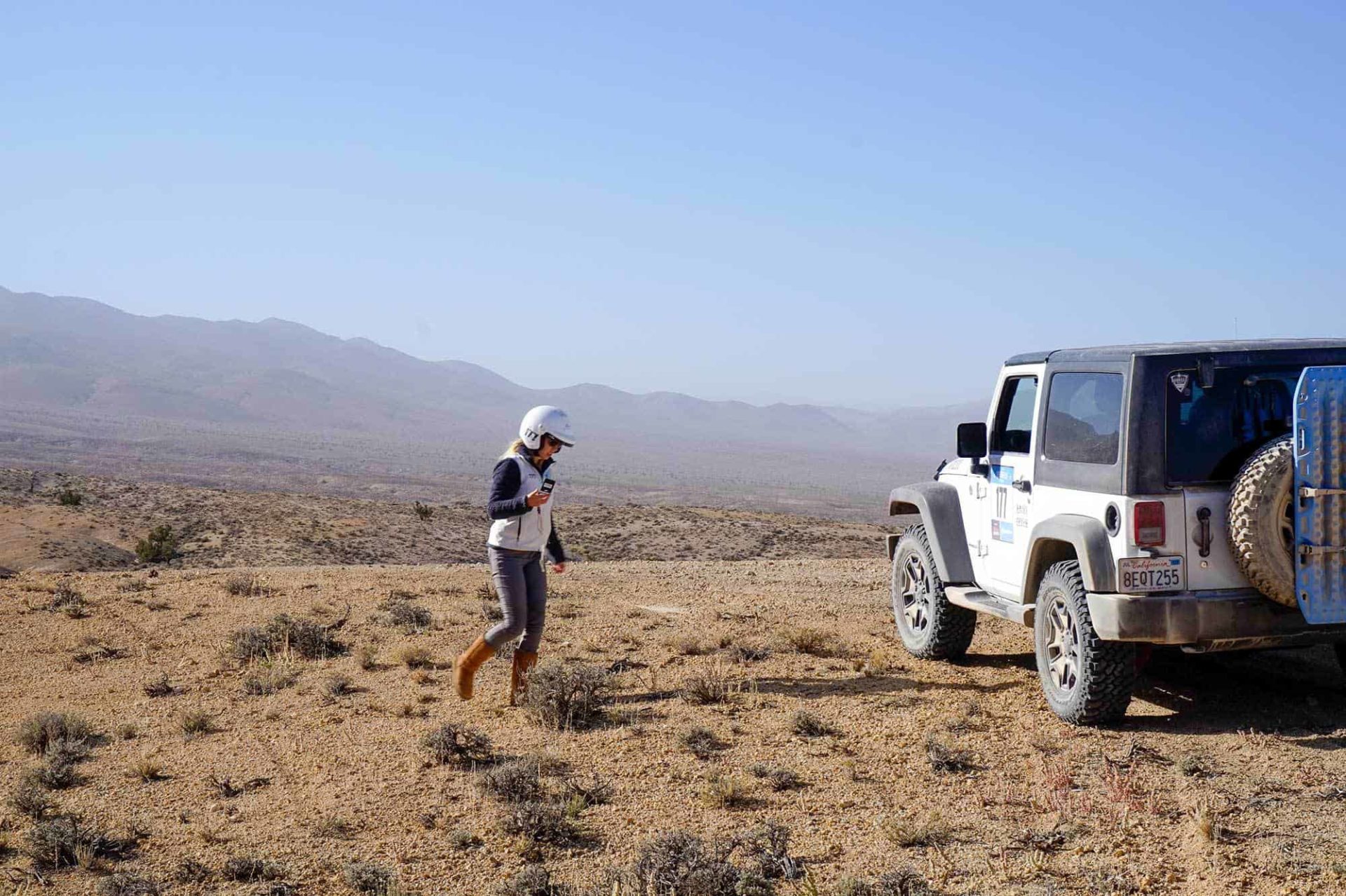
Rebelle for the day
The Rebelle Rally is not a race for speed, but for endurance and accuracy. I get to experience this first-hand on the first scored day of the competition. While I’m here as a journalist to cover the rally, not to compete in it, I’m given a real opportunity to experience what the competitors are going through.
As a temporary member of team Project Red, I get to spend a full day chasing checkpoints with Wendy Fisher, a former Olympic skier and close friend of Emily, the rally’s founder. The team name is inspired by Wendy’s red hair (she’s available for hire under the moniker “DJ Red”) combined with the bright red Jeep loaner we’ll be driving.
At first I’m intimidated by the concept of spending the day with Wendy—she’s a World Champion and huge deal in extreme skiing, and I’m admittedly a bit starstruck. But as soon as the rally starts, there’s no room for childish insecurities. It helps that Wendy is genuinely friendly and helpful—plus she’s done the Gazelle Rally in Morocco before, so she’s not a total rookie like I am.
My only previous experience with GPS-free navigation is the Rebelle Rally’s online navigation course. I took it ahead of the event, while wondering what in the world I had gotten myself into. Because of my inability to work a compass, Wendy has to do most of the navigating while I drive the Jeep.
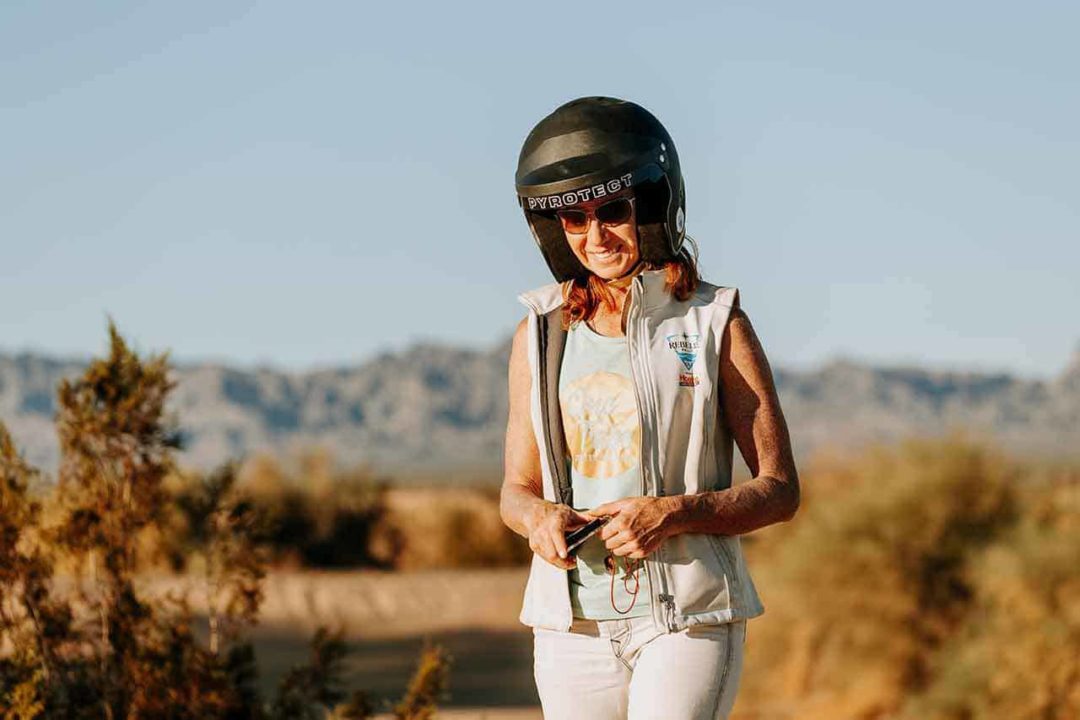
Since it’s a brand new vehicle with built-in GPS, rally officials have taped cardboard over the dashboard screen. Unable to work the radio without a display, we drive mostly in silence. The dirt roads are bumpy and washed out in places, so it’s not a quiet ride. Wendy stays hyper-focused on the map, intent on never losing track of where we are.
For the uninitiated, there are three different kinds of checkpoints in the Rebelle Rally. Green checkpoints are mandatory, and the easiest ones to find. They are also worth the highest number of points. Blue checkpoints are slightly trickier, and designed to keep competitors largely on the right track.
Black checkpoints are the toughest. Unlike green and blue, which are marked by flags or poles in the ground, black checkpoints are virtual. This means you have to be very precise in your plotting, and you won’t know if you actually found one until the scores are posted at the end of the day. And, I find out first-hand, it’s easy to doubt yourself while trying to translate your surroundings into features on a map.
“Heading and distance don’t lie,” Emily Miller told me. “What you can lie to yourself about, though, is the map. We call it ‘magic map.’ It’s when you think you’re somewhere on a map, and you’ve convinced yourself that you are, but you’re not.”
Actually finding a checkpoint is like a tiny adrenaline rush. Even rolling up to the green ones, marked by giant flags and pre-plotted on the competitors’ maps, is a real point of pride.
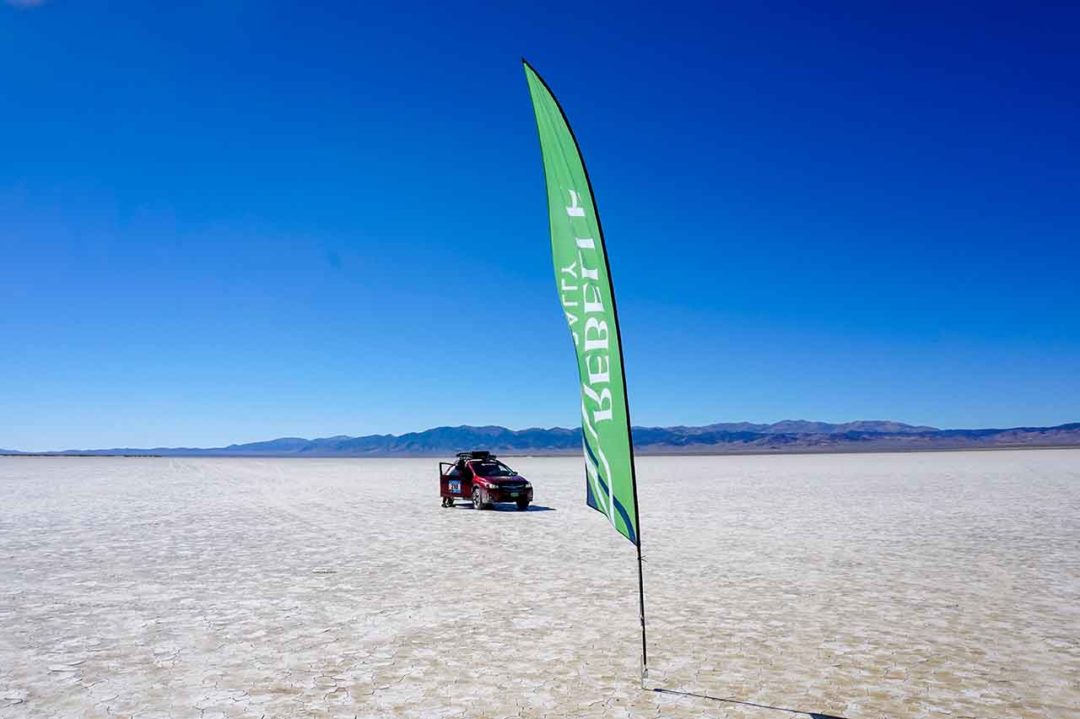
That morning, Wendy and I are the last team off the line, but one of the first to reach the day’s first green checkpoint. Neither of us have any idea how that happened. It took us several wrong turns just to find our way out of basecamp in the morning. Somehow, though, we make a pretty decent team.
As we approach the next checkpoint, positioned at the foot of a small—but steep—hill, we see several vehicles parked at the top. It’s not the way the map tells us to go, but we can’t resist driving up the hill to find out what’s going on. This, as it turns out, is one of our better decisions all day.
It’s a steep drive—so steep that for a moment I picture our Jeep flipping over and rolling backwards down the way we came from. I’m prone to imagining worst-case scenarios, and I quickly brush it out of my mind.
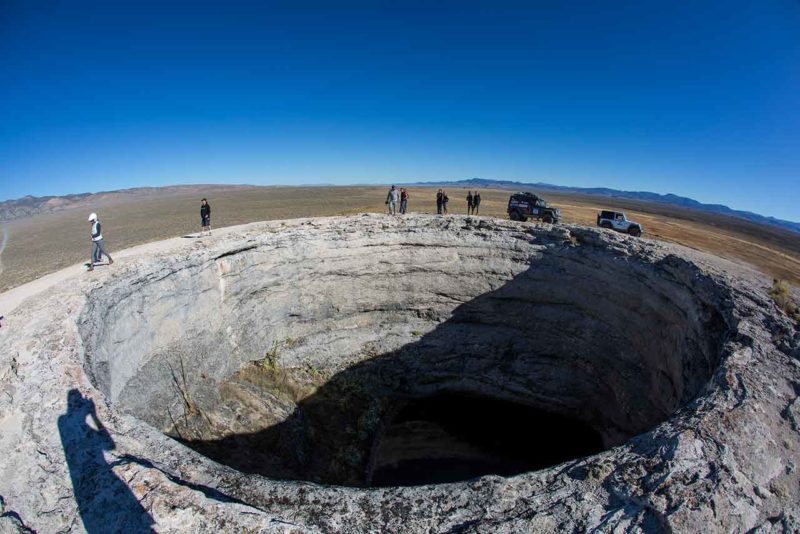
At the top of the hill is a deep crater, about 50 feet wide, enclosing a pool of water. There are no fences or warning signs, just a gaping, 30-foot deep hole straight into the earth. One step too close, and you could easily fall in. We learn later that this is a geothermal hot spring called Diana’s Punchbowl. The edge of its dome sits 600 feet above the desert and provides an excellent vantage point for what we’re about to head into next.
In every direction, there are mountains and desert, desolate except for the big dust clouds that indicate which directions the other competitors are driving in. It’s hard to stay incognito when driving up a dust storm. This can be a blessing or a curse—not all teams have been given the same route, so following another team is risky, even if it looks like you’re heading in the same direction.
One checkpoint at a time, we make our way through the day’s course, which takes us deep into Nevada’s mining country. The whole experience is cold, windy, exhausting, stressful, exhilarating, rewarding, and—for big parts of it—absolutely breathtakingly beautiful.
One part of the course runs along a narrow, windy mountain pass. To our immediate right is a steep cliff dropping deep into a valley of vegetation below. I’m white-knuckling the steering wheel and keeping my eyes on the path in front of me, while simultaneously trying to steal glances of the view. One of the competitors I talked to yesterday, who told me she’s deathly afraid of heights, pops into my head. I bet she hates this part of the route.
I’M WHITE-KNUCKLING THE STEERING WHEEL AND KEEPING MY EYES ON THE PATH IN FRONT OF ME, WHILE SIMULTANEOUSLY TRYING TO STEAL GLANCES OF THE VIEW.
Somehow, both Wendy and I have ended up wearing ill-fitting helmets. Our aching heads require us to repeatedly stop and remove or rearrange the helmet liners. This discomfort is there as a constant irritant throughout the day. For some reason, I thought all of this would be easier. When Wendy and I temporarily switch roles—she drives and I navigate—I barely lift my eyes from the map. I’m terrified of getting us lost. Driving seems like the lesser responsibility.
At one point, we’re both so hungry and exhausted that I’m pretty sure we’re about to get into a fight. It’s a weird feeling being this close to snapping at someone you just met. Despite being in the middle of a timed part of the competition, we pull over and cook lunch—freeze-dried pasta from the Rebelle pantry—on the side of the road, using Wendy’s camp stove. This turns out to be an easy solution to our impending hanger, and we don’t feel bad about missing a few points.
I imagine doing the entire rally with a close friend and wondering if we’d still be friends at the end of it. The pressure of staying on track, not getting lost, managing time and resources (there are no gas stations or stores out here), scoring as many points as possible, driving through challenging terrain, and getting back to basecamp before dark can easily become overbearing. In fact, we later hear a team lost one of the members when she had a breakdown and quit the competition. It seems to go one way or the other—the Rebelle either brings team members closer together or pushes them apart. It’s an emotional rollercoaster.
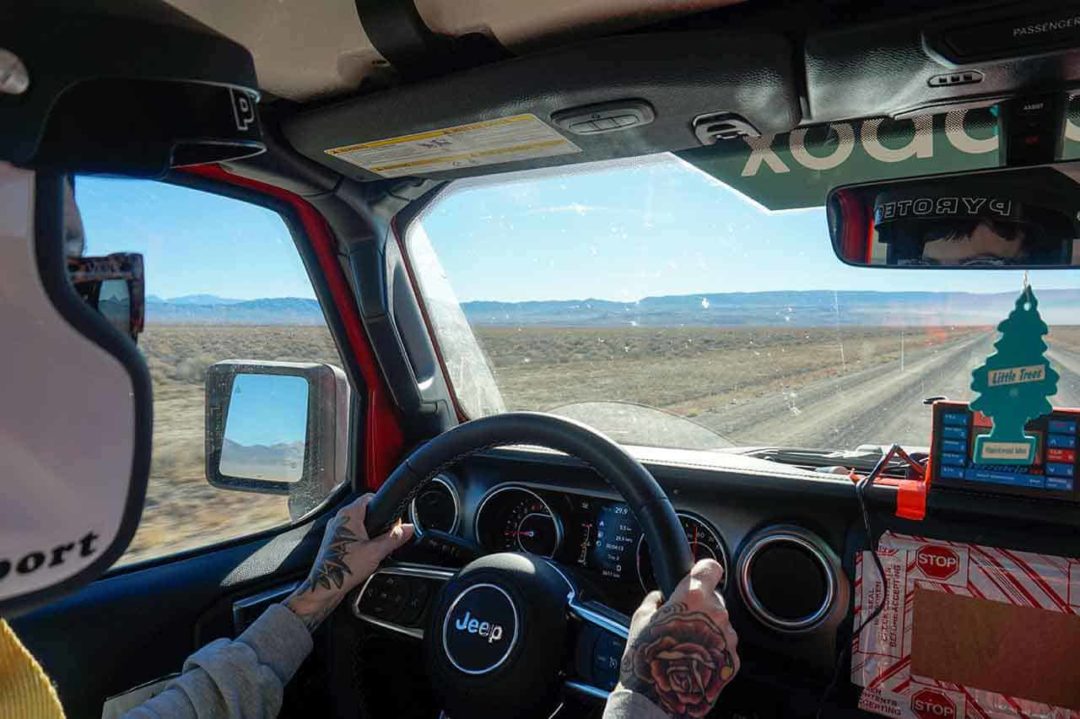
It takes Wendy and me almost 10 hours to make it to that evening’s basecamp. The last hour, we opt not to go for more checkpoints and instead take the paved highway back. It’s a cop-out, but we’re not here to win. We even manage to get the radio working, though it’s stuck on a station playing exclusively ‘80s music.
As we pull up to the end of the line heading into basecamp—The Go-Go’s “We Got the Beat” blasting through our speakers—Wendy jumps out and starts cleaning the windshield. Our red Jeep, which looked brand new and shiny earlier this morning, is now completely covered in mud. I’m so exhausted, I barely remember the last 10 hours. I certainly have no memory of driving through mud.
It doesn’t get easier
The morning of day four, I’m already awake by the time the camp’s cowbell alarm rings at 5 a.m. It’s been the coldest night yet—17 bone-chilling degrees—and I haven’t gotten many hours of solid sleep. It’s the kind of cold that chills your blood from the inside and takes hours, if not days, to fully recover from. As someone who lives in Southern California and considers everything below 65 degrees chilly, I’m almost comically unprepared for this.
While I’m considering never again leaving my sleeping bag, since it at least provides an elementary level of warmth, I overhear a conversation between two people just outside my tent.
Person one: “Did you sleep okay?”
Person two: “Like a baby.”
Person one: “You mean, waking up every two hours?”
Person two: “Oh, my bad. I mean I slept like an adult with no children.”
These ladies are clearly way more hard-core than I am.
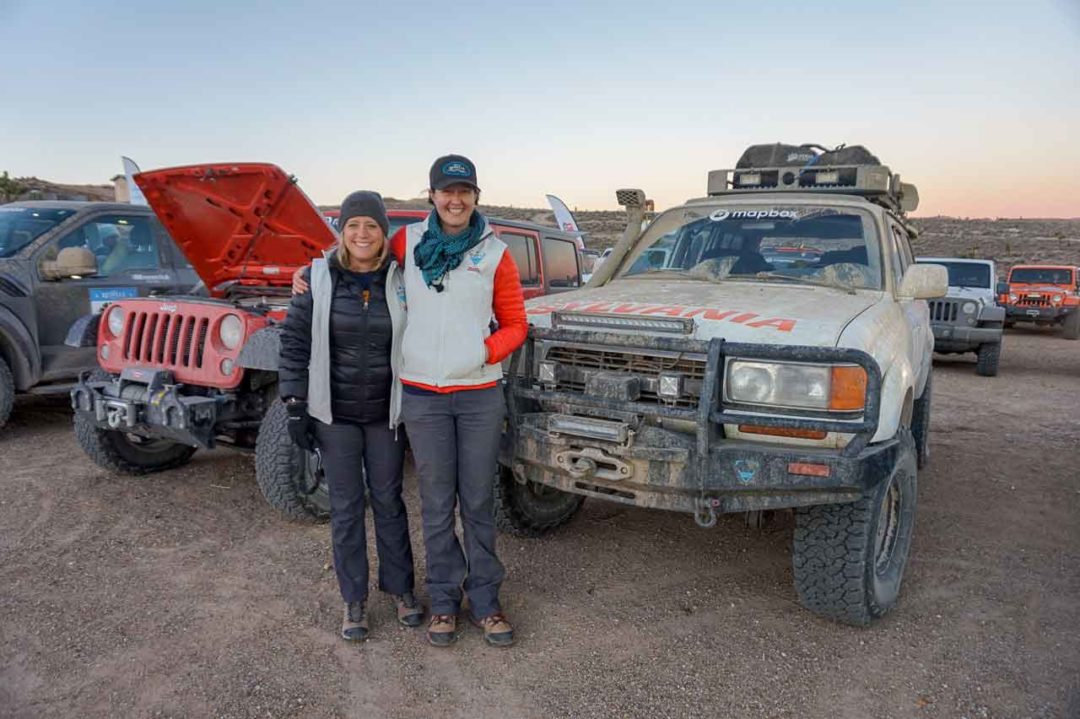
While a majority of the teams are first-timers, a few are returning Rebelles—meaning they’ve completed at least one of the previous two years’ rallies.
Being a Rebelle veteran doesn’t necessarily come with an advantage, though. According to Sedona Blinson, it doesn’t get easier. If anything, she says, it gets harder.
“[The organizers] know we are coming back, so they try to challenge us,” she says. “Parts of it get easier—like, we fall into the groove of things a lot faster. But you never know what they’re going to throw at you, so you have to be even more on your toes.”
Kendra Miller and Amy Hopkins of team Sassquatch Rebelles agree. Hailing from the Seattle, Washington area, both Kendra and Amy have competed in all Rebelle Rallies to date, though this is their first one together as a team.
IT’S VERY HUMBLING. IT DOESN’T MATTER HOW GOOD YOU ARE, OR HOW GOOD YOU WERE AT PREVIOUS RALLIES. YOU WILL ALWAYS HAVE A DAY THAT JUST KICKS YOUR ASS FOR WHATEVER REASON.
“The funny thing about the Rebelle is that it’s a very tempering event,” Kendra says. “It’s very humbling. It doesn’t matter how good you are, or how good you were at previous rallies. You will always have a day that just kicks your ass for whatever reason.”
Amy and she tell a story about the previous day of competition, which they started off full of confidence, as two experienced navigators who had completed the rally twice before. “We walked into this thinking that we already had it won,” Kendra says.
Then they made a “bonehead, rookie mistake” that proved to be crucial when it came time to add up the day’s score: They forgot to adjust the declination on their compass.
For non-navigators, magnetic declination is the difference between true north (the top of the globe) and magnetic north (where the compass needle points). It can vary several degrees depending on where you are, and needs to be manually accounted for—or you can end up miles in the wrong direction.
Amy and Kendra weren’t miles off their checkpoints—but at least a few hundred meters.
“It reminds you that you aren’t as great as you think you are,” Amy laughs.
An event worth the money
The Rebelle Rally is not for everyone. It takes a specific kind of personality to take pleasure in this level of mental and physical challenge, including the freezing cold nights, the staggeringly long days, and spending all that time with another person without getting on each others’ nerves.
Then there’s the entry fee. At $12,000 per team, it’s prohibitively expensive for most. And that doesn’t even cover the vehicle rental or modifications, or the many required or recommended items to bring: helmets (to be worn at all times during competition), fire extinguishers, navigating tools, camping gear, and more. For many teams, the total cost ends up being closer to $30,000.
But for the money you spend, you get an all-inclusive experience. Each basecamp—where competitors and staff spend the night—is its own luxury glamping experience, decorated with light strings, lanterns, and white tablecloths. And twice a day, teams are treated to dinner by Michelin-starred chef Drew Deckman, who takes an annual break from his acclaimed Baja, Mexico restaurant to cook for the Rebelles.
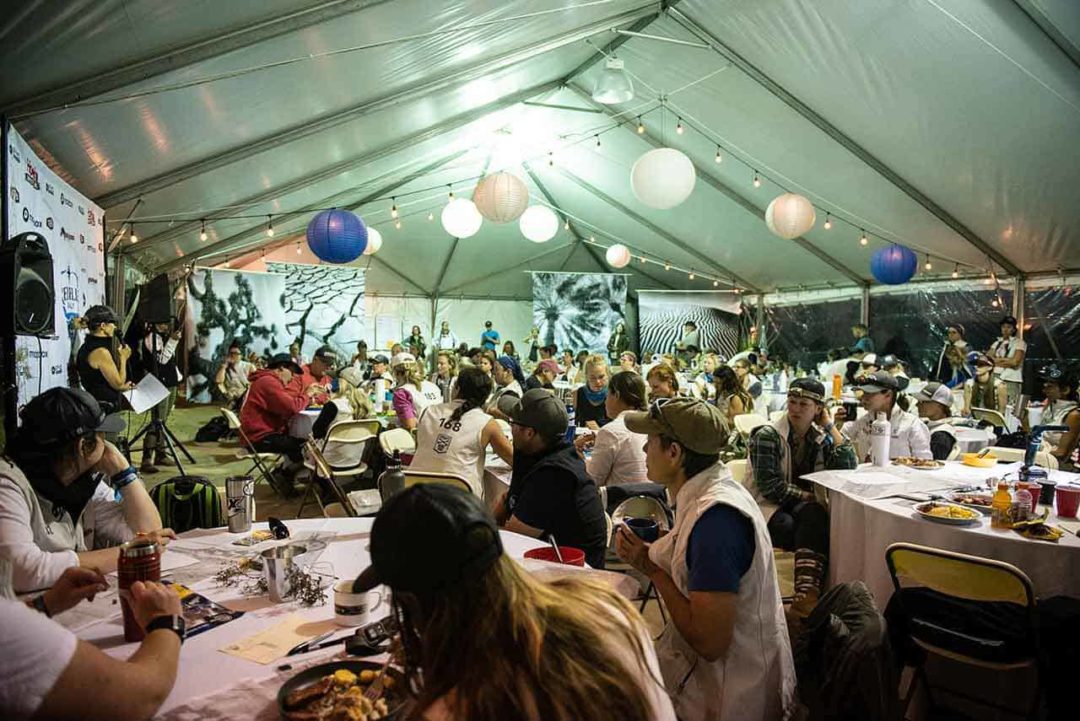
The event has a staff of over 60 people, including a rescue team and a mobile mechanic shop. There is a mind-boggling number of routes that have to be staked out in advance, which no doubt adds to the cost. So does acquiring the necessary permits and making sure every inch of the 1,600-mile route is being treated respectfully. The Rebelle Rally lives by the “Leave no trace” philosophy.
Despite having to save aggressively, fundraise, or find sponsors to help fund their rally experience, every single person I talk to say it’s worth the money. There’s a reason so many of them keep coming back year after year.
“This is a once-in-a-lifetime, bucket-list kind of thing,” says Kendra Miller. “You start it one way and come out the other end a completely different person, every single time.”
“The Rebelle Rally is wonderful that way,” Sedona Blinson agrees. “It gives women of all walks of life the chance to choose their wins. Whether it is to podium, to learn new skills, or to simply say, ‘I did that and finished.’ The Rebelle celebrates each of those accomplishments.”
To me, this is part of what makes the Rebelle Rally such a unique experience. It’s a competition, sure. It’s also a chance to overcome your own fears and insecurities and walk out on the other side a stronger, more confident person.
I didn’t actually finish the rally—I wasn’t even an official competitor—and yet I feel a sense of accomplishment unlike anything I’ve experienced before. I guess it’s time to start saving up that $12,000 for next year.

